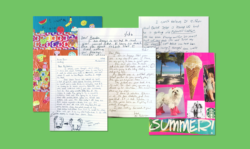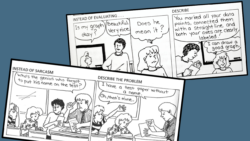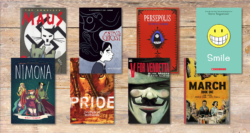
This is the fourth installment in a year-long series of written and video diary entries by Shelby Denhof, who is letting us follow her first year of teaching. To see all entries, click here. Links to all the books recommended in this post are Amazon affiliate links, which provide Cult of Pedagogy with a small commission on every purchase at no extra cost to you.
When I was hired, I didn’t have a single book to put on the shelves for my students.
At this point—now nearly through my first year of teaching—I have over five hundred books spread out around the room, organized by genre. Choice reading has quickly become a celebration with my seventh graders and a pivotal part of relationship-building with them.
Just weeks before the school year started, I reached out to the right person at the right time and was given over a hundred new, high-interest books for my room. An advocate for choice reading herself, this former teacher was retiring from the classroom and wanted to see those books put to good use. They made it into my hands.

I had them out and ready on the first day of school. By the second day, some of my students approached me about them: “Would it be okay if I looked at these?” each one of them asked timidly, gesturing to the shelves. Of course I said yes. As a few students got up, others followed. I couldn’t have been more excited.
Since then, books have circulated between the shelves and my students. There are a handful of books that are so sought after, my students created their own waiting list for them. It’s taped to the wall by the graphic novel section.
Talking about and sharing books has become such an integral part of my daily interactions with students, it’s difficult to pin down the magic it’s created, but the effects can be broken down into three distinct categories:
Books are exciting and offer opportunities for ownership.
When I get new books, I make a point of putting them out gradually and share each new book with my classes. I sell it to them. They see the cover. They hear what it’s about. They learn why I got it and who recommended it. I share just the right amount of juicy details. More times than not, it doesn’t even make it to the shelf before someone asks to check it out and others call dibs for later.
For two English units, my classes participate in book clubs instead of reading whole-class texts. While studying World War II and the Holocaust, my students choose between seven options, including Night, Between Shades of Gray, and The Book Thief. With our science fiction unit, there are even more options, from The Giver to Uglies to A Wrinkle in Time.
When it’s time to pick books, we spend a whole day exploring the options and learning about them to make sure students pick the best fit for them. The groups are student-led (with a healthy amount of scaffolding and guidance). Ultimately, though, they decide what they’d like to talk about. With this format, my students shine. They accept leadership roles in teaching other groups about their books and eagerly apply what we are learning about in class to their novels.

Outside of English 7, I teach an intervention course for students who struggle with reading comprehension. I inherited this class carte blanche: it’s mine to make what I want of it. With this exhilarating amount of freedom, I decided to dedicate the first twenty minutes of every class to choice reading. After all, the best way to get better at reading is to read. That holds true for excellent readers as well as reluctant readers. And trust me, my Reading Extensions kids are the epitome of reluctant readers.
What makes this class special, though, is how I’ve built the curriculum around what they are interested in. After a lengthy ‘interview’ process with each student at the beginning of the semester, I compile a detailed list of likes and dislikes and everything in between for each kid. I use that list to help dictate book clubs, suggest new reading options to students, and tailor nonfiction texts to each reader’s ability and interests. Much of the class is about teaching each other about the stories, novels, and articles each person is enjoying. This individualized curriculum helps to capture those kids who proudly identify as school-haters and help them build positive relationships with school, teachers, and peers, sometimes for the first time.
Books are something to talk about.
One awesome perk of the school I work in is that is that we have designated time for silent reading twice a week. This reading time, called Connect, is a half hour in the day for students to stop what they are doing and enjoy a good book, no matter what class they are in. While many teachers don’t like Connect, I do. I always look forward to it. For me, it provides that extra time to bond with my students through what they are reading. They spread out across the room, take out their books, and jump in. Oftentimes I join them, grabbing a book of my own and taking a seat next to some kids on the floor. I circulate from kid to kid, hearing about what they’re reading and asking questions. Luckily my seventh graders haven’t yet adopted the too-cool attitude of the eighth graders, who often seem more like demons than teenagers, and my students will happily talk on and on about their books. Just yesterday, for example, Chelsea came up to me, holding the book Bad Girls Don’t Die: “Miss Denhof, have you read this? It’s really freaky. It’s about this doll, and, oh my gosh, I couldn’t even fall asleep last night.”

“What book are you talking about?” Katie asked, her curiosity piqued. The book in her own hands was set down as she turned to listen more. Chelsea immediately jumped in, filling Katie in on all the tantalizing details. Katie made her promise to give it to her next.
These conversations are a dream. They are natural relationship-builders that—after finding that right book—don’t even require the gentlest push on my part. They are eager to share with one another and grow closer through that.
Book show I care.
If there’s one thing my kids know, it’s that I’m there for them. The relationships we’ve built through books is just a platform to show them that I’m listening, I’m invested in them, and I’m in their corner.
Levi came up to me on Monday and told me how he’s looking to start a new series. I sat down and brainstormed options with him, hearing about what he’s already finished and loved. During my prep hour, I researched more options online and gave him a list next day, including notes about which can be found in our school library.
Another student, Heather, is a former Reading Extensions student that fell in love with graphic novels. She wanted to read the fourth book in the Amulet series, which I didn’t have. I requested it at the library, had it sent to me, and watched her smile as I set it on her desk.
Jeremy—an avid reader—came up to me before first hour, thrilled to tell me about the crime novel he’d just finished. “There was a lot of bad language in it, but I think you should still get this for the classroom,” he explained. As he was trying to convince me, another student named Abby came up to me for a high five. “I finished it!” she said, giving me a rare smile. She held up Girl, Stolen. I congratulated her profusely, letting her know how proud I was of her for sticking with a book to the end.
Right now, my bookshelf doesn’t look much different than it did on the first day of school. There are more empty spaces on some shelves than filled ones, but for a new reason this time: The books are checked out! They are ready to frustrate and excite and scare and inspire and move these young readers, and I can’t wait to hear all about it. ♦
In this video, Shelby recommends some of her favorite books to read with her students:
Here are links to the books mentioned in the video:
The False Prince, by Jennifer A. Nielsen
The Compound, by S.A. Bodeen
Legend, by Marie Lu
Uglies, by Scott Westerfeld
If you’re a new teacher, the Cult of Pedagogy New Teacher Checklist will provide a structure to follow as you progress through the school year. To download a free copy, just sign up for our mailing list. Then you’ll get weekly e-mails with tips, tools, and inspiration to help you make your teaching better every day.





Hi Shelby, congratulations! You found a Marigold, and your students are the winners!
My coteacher and I do what you do: we put YAF all over the room. We let kids take them, and they don’t even have to give them back! (Most do, however.) We tell them that books are for sharing, so they can give them to a friend if they want. For popular reads like Shusterman’s Unwind series and his Skinjacker series, we buy them on Amazon, usually for a penny. That’s 3 or 4 dollars with shipping. (Since we aren’t brand-new teachers, we can afford to buy a few books here and there.)
We have kids who are confessed non-readers all-of-a-sudden begging for the next book! It’s amazing!!
It’s great that you’re doing this in 7th grade. We teach 9th- and 11th-graders, where “schooling” has had a chance to do more damage.
I love this! I’ve been using choice Lit Circles this year and my kids (10th grade) love them. I have 14 books–7 classics and 7 YA–and the only requirement is that they have to read at least one of the classics. They’re good, though–In Cold Blood, Catcher in the Rye, The Bluest Eye–all frequently banned and all on big topics. Next year I move up with them to 11th grade and am thinking of doing mainly YA novels. I’m excited at the conversations that they’re having. We’re a 1:1 school, so I have them record their discussions on their laptops so that I can listen later. That’s awesome for me! ? Keep up the great work!
Hi Shelby,
I taught L.A. for two years, along with social studies, until they split my colleague and I up and designated me as the social studies teacher for grade 6. I miss teaching L.A., and I like your approach to teaching, which was similar to mine. Many of my students are English language learners and I teach overseas. One thing my students really enjoyed was the book blog I created. I made them all authors or contributors. They enjoyed writing book reviews and we created book trailers at the end of the year. It was a blast and a nice way to celebrate a year of reading and writing. If you are a 1:1 school like my school or have good access to technology, they might enjoy a book blog. Connecting with other schools around the world via quadblogging or something like that would also be a great way to share their work.
http://mrmartinbookblog.blogspot.in/
Rob
Hi Shelby,
Congratulations on surviving and thriving in your first year! I did all choice based reading this year in my classroom and it was amazing! I teach in an independent school and my 5th graders have read almost 1,000 books this year! I’m transitioning to middle school next year and would love to swap titles with you!
Again, way to go!
I would LOVE to know more about the interview process you do with the kids at the beginning of the year. What questions do you ask to get them to share information that is useful?
I am beginning this year with a class much like yours – an extension period devoted to choice reading. I would love your interview questions, as well, along with any successful sharing activities you did. Thanks!
This is a great post! I had a similar experience during my first year in the classroom. I started with 0 books, was given a decent-sized collection by a retired teacher, and I slowly added to my classroom library throughout the year (primarily with free or discounted books through Scholastic book orders). I was teaching 4th grade, all subjects, so we did a lot of literature circles and whole-class novel studies. I would also read aloud my favorite books to the kids for about 10-15 minutes each day, usually after lunch. My first year was rough in a lot of ways, but I was able to bond with my class over the books we read and music we sang together. Just last year, I got an email from a former student from that very first class 25 years ago, and she mentioned how much she cherished the time our class spent reading and discussing the books we shared. It was a powerful reminder that some of the activities we do with our students will stay with them for the rest of their lives, which is why I believe it is unlike any other profession in the world. Best wishes as you finish out the school year, and make you take time over the summer to recharge for next year!
Thank you so much for sharing your experience as a first year teacher with reading. I am going into my first year this August and this post reminded me that my energy, enthusiasm, and work is going to be what leads my future students into their journey of reading. I’m so curious about the “lengthy” interview process. Is it a questioner they fill out or do you get to talk with them for a minute or two. I really want to try the idea of this interview and I hope that I can get non-readers to read!
I think the other thing that this helped me with is to not fear the idea of a lit circles in the first year. I have always like the idea of them and I would love to try it out for one of my units. Something I had an idea about was using lit circles as a companion novel type of use. Where they can pick a companion novel with the class book and then talk with and support the different students in their group who are reading the same book.